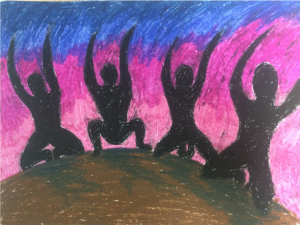DMT Brain Imaging Study
As part of the Beckley/Imperial collaboration, we have obtained fascinating results from our first ever placebo-controlled investigation of the effects of DMT on human brain activity.
The aims of the study were:
- To determine how DMT affects EEG recorded brain activity
- To establish the relationship between these brain activity measures, the real-time progression of the subjective experience and parallel changes in plasma levels of DMT
- To map more finely the relationship between brain activity and experience through the use of micro-phenomenological interviews, which promote detailed chronological accounts of subjective experiences, while reducing biases commonly associated with first person reports.
 Brain activity recorded during the peak of the DMT experience confirmed what we previously observed with other compounds such as LSD, i.e. a decrease in alpha frequencies (the main frequencies involved in normal consciousness) and an increase in signal complexity (put forward as a marker of state of consciousness, increasing from deep anaesthesia, to sleep, and to awake state).
Brain activity recorded during the peak of the DMT experience confirmed what we previously observed with other compounds such as LSD, i.e. a decrease in alpha frequencies (the main frequencies involved in normal consciousness) and an increase in signal complexity (put forward as a marker of state of consciousness, increasing from deep anaesthesia, to sleep, and to awake state).
However, the neural signature of the DMT experience included an increase in delta and theta waves, which are normally present during sleep, particularly when we dream. These changes have not been reported with other compounds such as psilocybin and LSD, and may reflect the complete immersive state that is unique to DMT (and 5-MeO-DMT).
Functional MRI was also used to record the changes in brain activity during the DMT experience. Results obtained using this imaging modality shows us how DMT alters the interaction between key brain networks, and enables a comparison to previously obtained results from our psilocybin and LSD studies.
As we continue, we are also planning an exciting research programme to investigate in a similar way, 5-MeO-DMT. Donations to contribute to this ground-breaking research are greatly appreciated.
Podcast
- All
Links
- All
Support
- All
BIPRP
- All
Science Talk
- All
Amanda's Talks
- All
- Video Talk
- Featured
- 2016 Onwards
- 2011-2015
- 2010 and Earlier
- Science Talk
- Policy Talk
One-pager
- All
Music
- All
Amanda Feilding
- All
Events
- All
Highlights
- All
Psilocybin for Depression
- All
Current
- All
Category
- All
- Science
- Policy
- Culture
Substance/Method
- All
- Opiates
- Novel Psychoactive Substances
- Meditation
- Trepanation
- LSD
- Psilocybin
- Cannabis/cannabinoids
- Ayahuasca/DMT
- Coca/Cocaine
- MDMA
Collaboration
- All
- Beckley/Brazil Research Programme
- Beckley/Maastricht Research Programme
- Exeter University
- ICEERS
- Beckley/Sant Pau Research Programme
- University College London
- New York University
- Cardiff University
- Madrid Computense University
- Ethnobotanicals Research Programme
- Freiburg University
- Medical Office for Psychiatry and Psychotherapy, Solothurn
- Beckley/Sechenov Institute Research programme
- Hannover Medical School
- Beckley/Imperial Research Programme
- King's College London
- Johns Hopkins University
Clinical Application
- All
- Depression
- Addictions
- Anxiety
- Psychosis
- PTSD
- Cancer
- Cluster Headaches
Policy Focus
- All
- Policy Reports
- Advisory Work
- Seminar Series
- Advocacy/Campaigns
Type of publication
- All
- Original research
- Report
- Review
- Opinion/Correspondence
- Book
- Book chapter
- Conference abstract
- Petition/campaign
Search type

